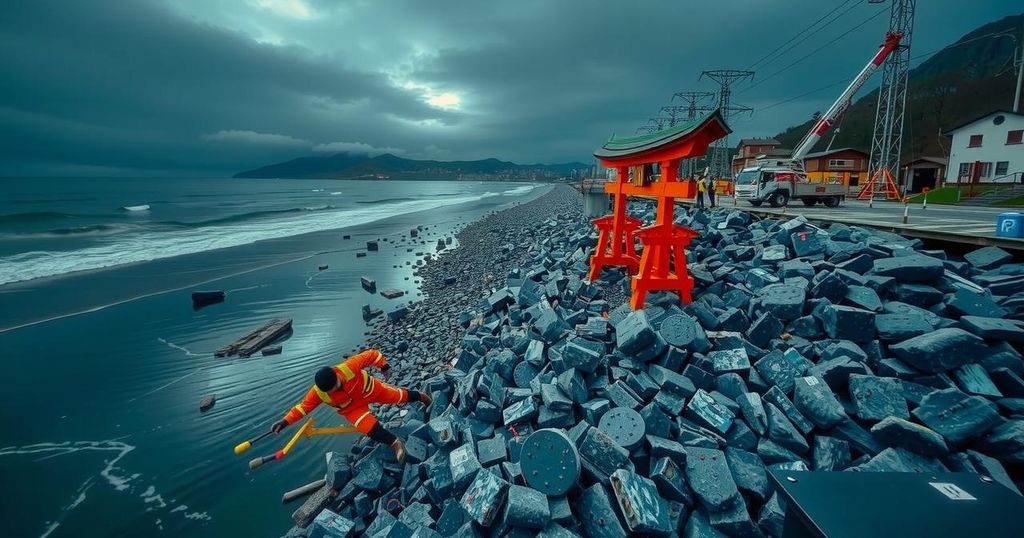The 2011 Japan Earthquake and Tsunami: Aftermath and Recovery
The March 11, 2011 earthquake and tsunami in Japan resulted in over 10,000 confirmed deaths and significant infrastructural destruction, particularly in the coastal Tōhoku region. The disaster prompted a nuclear crisis at the Fukushima Daiichi power plant, leading to evacuations and radiation fears. Over time, recovery efforts began, with emphasis on rebuilding and addressing long-term safety concerns.
On March 11, 2011, Japan experienced a catastrophic earthquake followed by an equally devastating tsunami, leading to widespread destruction and significant casualties. The immediate aftermath revealed initial casualty figures that quickly escalated, with over 10,000 confirmed dead and more than 28,500 unaccounted for within weeks. The tsunami severely impacted coastal communities, washing away homes, vehicles, and local infrastructures. Areas such as Miyagi suffered the highest toll, with over 10,800 fatalities. It became evident that the majority of victims died from drowning, with most casualties occurring among the elderly population. The earthquake itself caused extensive damage beyond the coastal flooding. Fires erupted in key locations, including petrochemical facilities in Sendai, contributing to both property damage and loss of life. The earthquake compromised crucial infrastructure, rendering roads and rail lines inoperable, disrupting electric power, and damaging water systems. Among the profound concerns following the disaster was the status of nuclear power plants in the Tōhoku region. The Fukushima Daiichi Nuclear Power Station, located along the northeastern coast, experienced critical failures as tsunami waves damaged backup generators, leading to reactor cooling system breakdowns. This resulted in partial meltdowns of three reactors, releasing radioactive material into the environment. Authorities initiated an extensive evacuation, establishing a no-fly zone around the facility to mitigate radiation exposure risks. In the weeks that followed, the Japanese government faced severe challenges managing the nuclear crisis, culminating in an upgrade of the incident’s severity level to 7, designating it as historically significant as the Chernobyl disaster. By the end of 2011, however, officials reported progress in stabilizing the plant and began allowing some residents to return. Nonetheless, local food and water supplies were contaminated, necessitating widespread warnings and safety measures. In summary, the combination of a major earthquake and tsunami in 2011 caused unparalleled loss of life and economic damage in Japan. Recovery efforts have been ongoing, and issues of nuclear safety continue to persist, highlighting the disaster’s far-reaching implications.
The earthquake and tsunami on March 11, 2011, marked one of the most devastating natural disasters in Japan’s history. It resulted in unprecedented loss of life and extensive property damage, particularly in the Tōhoku region along the Pacific coast. The tsunami’s impact was direct and catastrophic, ravaging coastal towns and inundating farmland. Additionally, the disaster had profound implications for nuclear energy safety, leading to a severe crisis at the Fukushima Daiichi Nuclear Power Station. The aftermath necessitated significant governmental response, both in terms of immediate disaster relief and long-term recovery and rebuilding efforts.
The 2011 earthquake and tsunami in Japan highlighted the vulnerability of coastal regions to natural disasters and raised serious questions about the safety and emergency preparedness of nuclear power facilities. While recovery efforts have made progress in rebuilding affected communities and stabilizing nuclear facilities, the long-lasting impact on infrastructure and public health remains a critical concern. The lessons learned from the disaster are crucial in guiding future policies on disaster preparedness, response, and energy safety.
Original Source: www.britannica.com




Post Comment